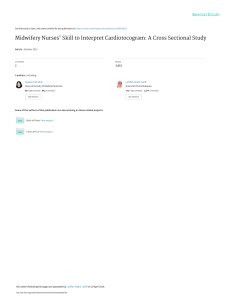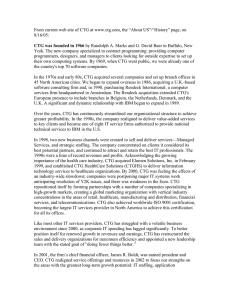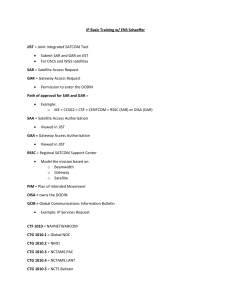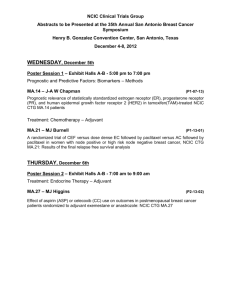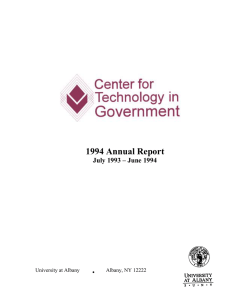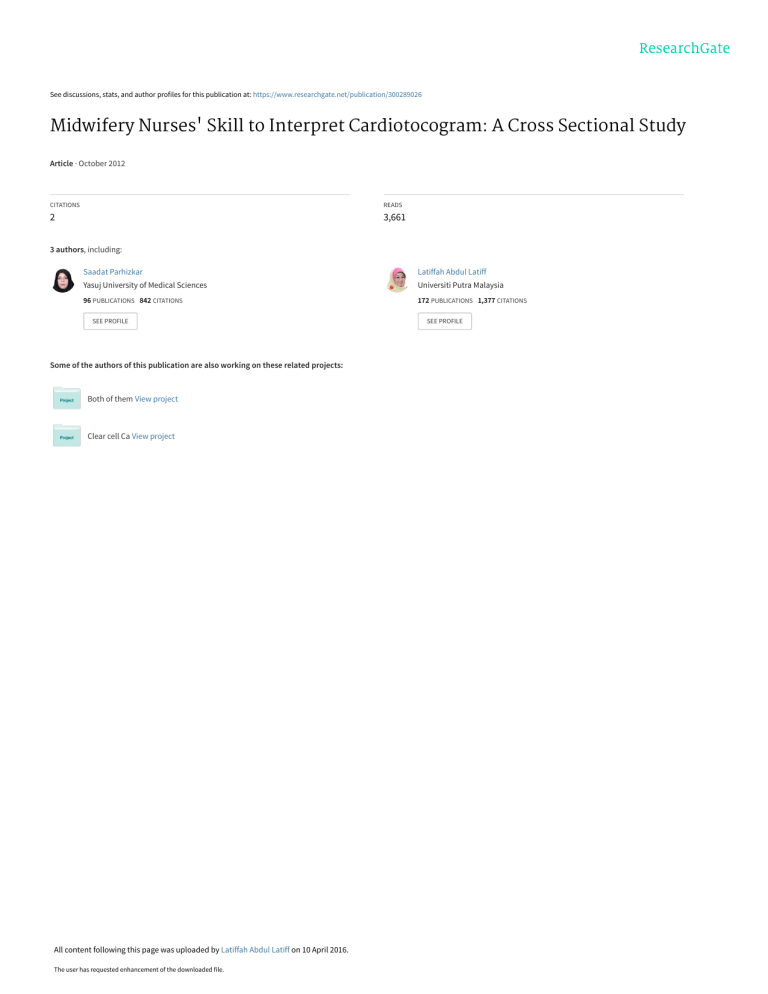
See discussions, stats, and author profiles for this publication at: https://www.researchgate.net/publication/300289026 Midwifery Nurses' Skill to Interpret Cardiotocogram: A Cross Sectional Study Article · October 2012 CITATIONS READS 2 3,661 3 authors, including: Saadat Parhizkar Latiffah Abdul Latiff Yasuj University of Medical Sciences Universiti Putra Malaysia 96 PUBLICATIONS 842 CITATIONS 172 PUBLICATIONS 1,377 CITATIONS SEE PROFILE Some of the authors of this publication are also working on these related projects: Both of them View project Clear cell Ca View project All content following this page was uploaded by Latiffah Abdul Latiff on 10 April 2016. The user has requested enhancement of the downloaded file. SEE PROFILE International Journal of Health Sciences and Research www.ijhsr.org ISSN: 2249-9571 Original Research Article Midwifery Nurses’ Skill to Interpret Cardiotocogram: A Cross Sectional Study Saadat Parhizkar1, Latiffah A. Latiff2*, Norziah B. Aman2 1 Social Determinants of Health Research Center, Yasuj University of Health and Medical Sciences (YUMS), Iran 2 Department of Community Health, Faculty of Medicine and Health Sciences, University Putra Malaysia * Correspondence Email: llatiffah@gmail.com Received: 29/08//2012 Revised: 14/09/2012 Accepted: 21/09/2012 ABSTRACT The cardiotocogram (CTG) consists of a continuous recording of fetal heart rate and maternal contractions during labour. CTG interpretation is a difficult task, requiring clinical experience and significant expertise. Lack of knowledge of interpreting CTG will lead to inaccurate decision to perform caesarean section. The purpose of current study was to determine the level of knowledge on the interpretation of Cardiotocography (CTG) and its associated factors amongst midwifery nurses in Hospital Putrajaya and Hospital Serdang. Universal sampling method was used in this study. A total of 165 midwifery nurses from labour and delivery unit and obstetric wards in the two hospitals were given a set of questionnaires consisting of common recording of fetal heart rates, uterine activities and case scenarios. Finding revealed inadequate knowledge of respondents regarding interpretation and diagnosis of different graph in CTG. There were significant association between age (p=0.01), education level (p=0.05) and knowledge on CTGs interpretation. Result also indicated a significant association between frequency on CTG interpretation with knowledge on CTG (p=0.01). The result of current study revealed the need for an effective training program which would help to improve CTG interpretation skill by midwifery nurses which would ultimately benefit mothers and babies. Keywords: Knowledge, Cardiotocogram, Midwifery Nurses, Hospital Putrajaya, Hospital Serdang Malaysia developed. Severe hypoxic injury can leads to neurodevelopment disability and cerebral INTRODUCTION palsy or even death. Electronic fetal During labour fetus can repetitively monitoring (EFM) can be used to diagnose suffer by oxygen insufficiency and as a the hypoxia and thus prevent these adverse consequence the metabolic acidosis can be outcomes. (1) International Journal of Health Sciences & Research (www.ijhsr.org) Vol.2; Issue: 6; September 2012 28 EFM has become a generally accepted method for the fetal surveillance during pregnancy and labour and offers important information about the fetus behavior. EFM involves the cardiotocogram (CTG), which consists of two signals, i.e. the intrauterine pressure (IUP) and the instantaneous activity of fetal heart (fHR) or as recently introduced fetal electrocardiogram (fECG). Clinical risk management is becoming inherent within midwifery and obstetric practice. (2) Certainly incorrect interpretation of CTGs and ensure action take potentially high risk of harm to women and babies. According to NMC (3) it is the responsibility of each practitioner to ensure that they remain clinically updated and co-operate with Department of Health guidance relating to minimizing risk for women and babies. (4, 5) The introduction of CTG monitoring to clinical practice significantly reduced the incidence of birth asphyxia; however, on the other hand it has contributed to the rise of cesarean section. (6) This has been a consequence of poor interpretation of fetal behavior and CTG signals. The guidelines for the CTG were introduced (7, 8) in order to improve the interpretations and thus lower the number of born children with acidosis and decrease the rate of cesarean sections as well. A recently published paper (6) concluded that the main reason for the poor outcomes lies in the generally poor standard of CTG interpretation and the contribution of human factor as well. Therefore, more intense training on CTG interpretation should be performed (9, 10) or more costeffective solution by developing an expert system (6) should be used. The numbers of studies that specifically attempt to examine knowledge on CTG are relatively few in number. Thus, it is evident that there is a need to build on the data about nurses’ knowledge on CTG interpretation in hospitals to receive a comprehensive decision regarding its improvement. So, we undertook this study to map existing knowledge of midwifery nurses on CTG interpretation and to identify its associated factors amongst midwifery nurses in Hospital Putrajaya and Hospital Serdang, Malaysia. MATERIALS AND METHODS A cross-sectional study was carried out among midwifery nurses who are working at Obstetric Wards and Labour & Delivery Units Hospital Putrajaya and Hospital Serdang in Malaysia. Universal sampling method has been used in this study. A list of midwifery nurses who are working at the obstetric ward and Labour Delivery units of Hospital Putrajaya and Hospital Serdang within the study period was obtained from the Human Resources Department of Hospital Putrajaya and Hospital Serdang. Subsequently all the subjects including 180 midwifery nurses (Hospital Putrajaya: n=96 and Hospital Serdang: n=84) in the list have been taken as a sampled of study. Approval was obtained from Director of both Hospitals before the distribution of the questionnaire among midwifery nurses. Instrument A validated and reliable selfadministered, structured questionnaire was used for data collection. Questionnaire was adapted from the Women’s CPG: Algorithm: cardiotocograph (CTG) interpretation and action. Content validity of the questionnaire was ascertained by an expert panel, which comprised six Obstetrician Hospital Putrajaya and Hospital Serdang. A pilot study was conducted with 10 midwives from Labour & Delivery Unit of Hospital Kajang to examine the reliability of the adapted instruments. Reliability (internal consistency) was assessed using Cronbach’s alpha. The Cronbach’s alpha International Journal of Health Sciences & Research (www.ijhsr.org) Vol.2; Issue: 6; September 2012 29 coefficient was 0.94, indicated adequate reliability of the questionnaire. The questionnaires consisted of 55 questions and were divided into three sections including socio-demographic information, respondents’ knowledge on interpretation CTG and other factors contribute to level of knowledge on interpretation CTG. Out of 180 respondents, 165 midwifery nurses were participated in this study thus giving a response rate of 91.6%. Almost of the respondents were belonged to Malay ethnicity (89.6%) followed by Indian (6.6%) and either Chinese or others (1.8%). The finding showed 97 (58.8%) of the respondents are Nursing Certificate holder and working as Community Nurse. The rest 68 (41.2%) has Diploma in Nursing with 1 year course in midwifery and designation as Midwifery Nurse. Majority of nurses (65.5%) had 1 to 5 years working experience and extremely half of them (57.6%) were working in Labour and Delivery unites. Table 1 showed the majority of midwifery frequently interpreted the CTG between 1 to 5 times and only 37 (22.6%) of them are interpreted more than 10 times in one shift. Data analysis Statistical analyses were performed using SPSS version 14. The Mann-Whitney U test and Kruskal –Wallis tests were used for analysis of data. Significance was accorded when p< 0.05. RESULTS Table 1: Frequency of CTG interpretation by midwifery nurses in one shift Frequencies of CTG interpretation TOTAL n (%) SERDANG HOSPITAL n (%) 1 to 5 times 72 43.7 27 16.4 45 27.3 6 to 10 times 56 34 24 14.5 32 19.4 11 to 15 times 20 12.2 14 8.5 6 3.6 more than 15 times 17 10.4 12 7.3 5 3.0 Total 165 100 77 46.7 88 53.3 Current study assessed the knowledge of nurses regarding interpretation of CTG graphs. Six figures of Normal CTG, Bradycardia graph, Tachycardia graph, Type 1 deceleration graph, Type II deceleration graph and lastly Prolong deceleration graph selected as instrument of the study. For each graph is consist of 6 questions and every question is produce to evaluate their knowledge. More than 3/4 of respondents were able to answer just 25% of questions PUTRAJAYA HOSPITAL n (%) correctly and only 24.8% of them are able to answered at least 75 percent of questions correctly. The study showed midwifery average marks for interpreting the normal graph are 73.13 percent. More than half of the respondents (67%) are unable to answer Q3 correctly. The analysis shows that majority of midwifery able to answer Q1, Q2, Q4, Q5 and Q6 for Normal Graph correctly (Table 2). International Journal of Health Sciences & Research (www.ijhsr.org) Vol.2; Issue: 6; September 2012 30 Table 2: Ability to recognize specific CTG interpretation in different graphs. CTG Diagnosis n (%) Q1 Q2 Q3 Q4 Q5 Q6 Normal Graph (F1) 121 (73.3) 77 (46.7) 54 (32.7) 159 (94.60) 162 (98.2) 151 (91.5) 75 (45.5) 142 (86.1) 96 (58.2) 131 (79.4) 60 (36.4) 149 (90.3) 159 (96.4) 138 (83.6) 161 (97.6) 162 (8.20) 145 (87.9) 146 (88.5) 134 (81.2) 127 (77) 129 (78.2) Bradicardia Graph 131 54 132 (F2) (79.4) (32.7) (80) Tachycardia Graph 123 98 124 (F3) (74.5) (59.4) (75.20) Type I Deceleration 105 90 102 Graph (F4) (63.6) (54.5) (61.8) Type II Deceleration 102 40 143 Graph (F5) (61.8) (24.4) (86.7) Prolonged Deceleration 51 105 56 Graph (F6) (30.9) (63.6) (33.0) Q1 = Identify the baseline Q2 = Identify the baseline variability Q3 = Identify the uterine activity Q4 = Identify the diagnosis for graph Q5 = Identify the graph is normal or not Q6 = Action that necessary taken when see the graph. Respondents for both hospitals having most problems to identify the baseline variability for the graph, result showed that respondents were able to identified and interpret the graph correctly 32.7% and 24.4% for Bradycardia graph and Type II deceleration respectively. As second problem respondents had difficulty to identify the uterine activity or to identify the contraction that mother having in 10 minutes. Extremely one third of respondents (32.7%) confronted difficulty to identify it from Normal graph and 33.9% respondents had problem to identify it from Prolong deceleration graph. The third problem was difficulty of respondents to identify the diagnosis for every different graph that revealed correct answers 45.5% and 36.4% for Bradycardia graph and Prolong deceleration graph respectively. One hundred and forty of respondents (69.1%) reported that heavy workload influence them the ability to interpret CTG (Figure 1). According to 52.1% of respondents, increase number of Mean Marks 73.13 69.29 80.00 67.17 71.11 56.87 patient in wards also determined as influence them to interpret CTG. Only 71 (43%) of nurses believed that lack of staff or midwifery nurses also influence the ability to interpret CTG. influence them to interpret CTG. 30.9% Yes 69.1% No Figure 1: Heavy workload influence the ability to interpret CTG (n=165) The finding revealed that there is a significant relationship between knowledge on interpretation of CTG and respondents’ age, educational level and work experience (p<0.05). The results also showed no significant relationship between International Journal of Health Sciences & Research (www.ijhsr.org) Vol.2; Issue: 6; September 2012 31 respondents’ knowledge on interpretation and their ethnicity. CTG DISCUSSION Finding revealed inadequate knowledge of respondents regarding interpretation and diagnosis of different graph in CTG. Previous studies have identified highest levels of agreement in assessment of baseline rate and lowest levels of agreement in the assessment of baseline variability. (11-15) It has been suggested that, despite its well documented limitations, (16, 17) EFM has become the most widely used method of assessing fetal well-being during labour. (18) Consequently, the ability to accurately and reliably interpret CTG tracings has become a fundamental skill required of midwives and all who are responsible for caring for women during pregnancy and labour. Failure to use EFM when clinically indicated, misrecognition and misinterpretation of abnormal FHR patterns, inappropriate action after abnormal FHR pattern identification and inconsistency in the interpretation of CTG tracings have all been identified as problems associated with the use of intrapartum EFM. (19, 20) There were significant association between age (p<0.01), education level (p<0.05) and knowledge on CTGs interpretation. This result was in agreement with study done by other researcher (21) who reported that midwifery nurses with a higher education level have a better means of interpreting the CTGs and implementing policies. These findings are comparable to Omery and William’s (22) qualitative study in which they found that the higher level of education, the more likely the nurse was to implement research findings and be involved in research utilization. Result also indicated a significant association between frequency on CTG interpretation with knowledge on CTG (p<0.01). Similar result also showed by Wahlin and his colleagues. (23) Dewey (24) believes that all leaning stems from experience, but not all experience results in learning. Benner (25) suggested that expert nurses are able through experience and critical thinking, to integrate analytic and logical problem solving. CONCLUSION The study highlighted a number of issues relating to CTG usage. The findings from this study indicated that midwifery nurses who participated in this study would benefit from attending joint training on fetal heart rate monitoring and interpretation. This could be facilitated by providing workshops on CTG usage and interpretation in order to update staff thereby improving communication and collaboration. This may also improve midwifery nurses’ confidence levels in using and interpreting CTG tracings. REFERENCES 1. Chudacek, V., Spilka, J., Rubackova, B., Koucky, M., Georgoulas, G., Lhotska, C . 2008. Evaluation of Feature Subsets for Classification of Cardiotocographic Recordings. Computers in Cardiology;35:845−848. 2. Wilson., J., H, Symon., A. 2002. Clinical risk management in midwifery. Books for midwives, Oxford. 3. NMC (Nursing Midwives College) 2004. Midwives rules and standards. NMC, London. 4. DoH (Department of Health) 2001. Building a safer NHS for patients. DoH London. International Journal of Health Sciences & Research (www.ijhsr.org) Vol.2; Issue: 6; September 2012 32 5. DoH (Department of Health) 2003. Delivering the best. Midwives contribution to the NHS Plan. DoH, London. 6. Steer, P.J. 2008. Has electronic fetal heart rate monitoring made a difference. Seminars in Fetal and Neonatal Medicine. 13:2–7. 7. FIGO. 1986.Guidelines for the use of fetal monitoring. International Journal of Gynecology Obstetrics. 25:159–167. 8. NIH. 1997. Electronic fetal heart rate monitoring: researchguidelines for interpretation. National Institute of Child Health and Human Development Research Planning Workshop. Am J Obstet Gynecol.177(6):1385–1390. 9. Doria, V., Papageorghiou, A.T., Gustafsson, A., Ugwumadu, A., Farrer, K., Arulkumaran, S. 2007. Review of the first 1502 cases of ECG-ST waveform analysis during labour in a teaching hospital. BJOG;114(10):1202–1207. 10. Westerhuis, M., Kwee, A., van Ginkel, A., Drogtrop, A., Gyselaers, W., Vissera, G. 2007. Limitations of ST analysis in clinical practice: three cases of intrapartum metabolic acidosis. BJOG an International Journal of Obstetrics and Gynaecology.114:1194–1201. 11. Hayashi, M., Nakai, A., Sekiguchi, A. and Takeshita, T. 2012. Fetal Heart Rate Classification proposed by the Perinatalogy Committee of the Japan Society of Obstetrics and Gynecology: Reproductibility and Clinical Usefulness. J Nippon Med. Sch 2012;29(1); 60-68. 12. James, D.K., Steer, P.J., Weiner, C.P., Gonik, B. 2006. High risk pregnancy: management options. 3rd ed. Philadelphia: Elsevier Saunders. 13. Bocking, A.D. 2003. Assessment of fetal heart rate and fetal movements in detecting oxygen deprivation inuterus. Eur J Obstet Gynecol Reprod Biol. 110 Suppl 1:S108-S112. 14. Bernades, J., Costa-Pereira, A., Ayres-de-Campos, D., Van Geijin, H..P. & Pereira-Leite, L. 1997. Evaluation of interobserver agreement of cardiotocograms. International journal of Gynecology 106, 1307-1310. 15. Trimbos, J.B. and Keirse, M.J.N.C. 1978. Observer variability in assessment of antepartum cardiotocograms. British Journal of Obstetrics and Gynaecology. 85, 900 -906. 16. Neilson, J.P. 2008. Fetal electrocardiogram (ECG) for fetal monitoring during labour.Cochrane Database Syst Rev 2008; 1: CD000116. 17. Thacker, S.B., Stroup, D.F., Chang, M. 2001. Continuous electronic heart rate monitoring for fetal assessment during labor. In: The Cochrane Library, Issue 2. John Wiley & Sons, Ltd, Chichester, UK. TICLE IN PRESS 18. Devane, D., Lalor, J.G., Daly, S., McGuire, W., Smith, V. 2012. Cardiotocography versus intermittent auscultation of fetal heart on admission to labour ward for assessment of fetal wellbeing. Cochrane Database of Systematic Reviews, Issue 2, Art. No.: CD005122. 19. Maternal and Child Health Research Consortium. 2000. Confidential Enquiry into Stillbirths and Deaths in Infancy (CESDI): 7th Annual Report. Maternal and Child Health Research Consortium, London. International Journal of Health Sciences & Research (www.ijhsr.org) Vol.2; Issue: 6; September 2012 33 20. Maternal and Child Health Research Consortium. 2001. Confidential Enquiry into Stillbirths and Deaths in Infancy (CESDI): 8th Annual Report. Maternal and Child Health Research Consortium, London. 21. Longley, M., Shaw, C. and Dolan, G. 2007. Alternative Scenarios for Healthcare, Nursing and Nurse Education in the UK in 2015. Welsh Institute for Health and Social Care, Faculty of Health Sport and Science, University of Glamorgan, Pontypridd. 22. Omery, A., Williams R. P. 1999. An appraisal of research utilization across the United States. Journal Nursing Adm., 29: 5-56. 23. Amer-Wahlin , I., Arulkumaran, S., Hagberg, H., Marsal, K., Visser, G.H. 2007. Fetal electrocardiogram: ST waveform analysis in intrapartum surveillance. BJOG;114: 1191–1193. 24. Dewey., J. 1993. How we think. D.C. Helth, Boston. 25. Benner; P., Hughes, R. G. and Sutphen, M. 2008. Clinical Reasoning, Decision making, and Action: Thinking critically and clinically. Philadelphia: WB Saunders. ************************** International Journal of Health Sciences & Research (www.ijhsr.org) Vol.2; Issue: 6; September 2012 View publication stats 34

